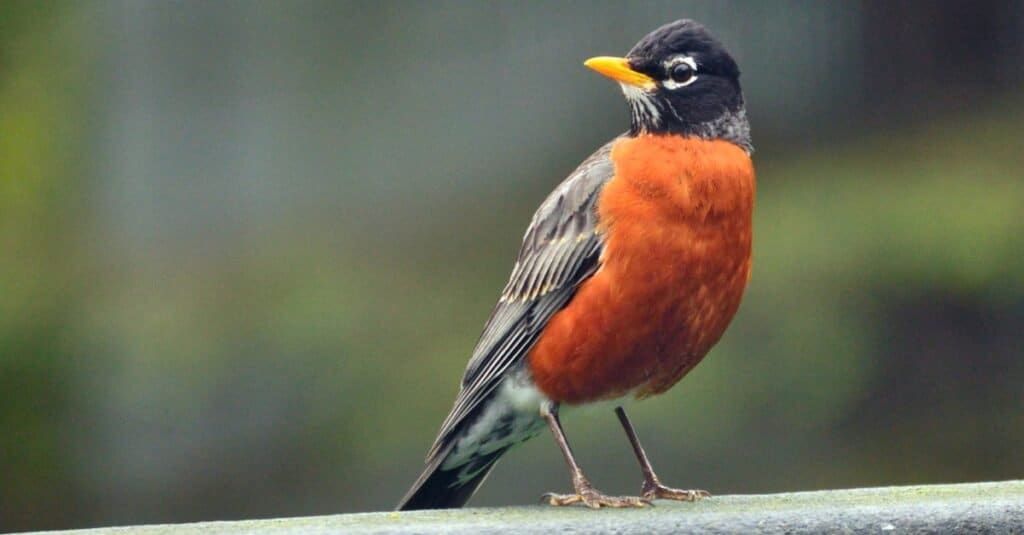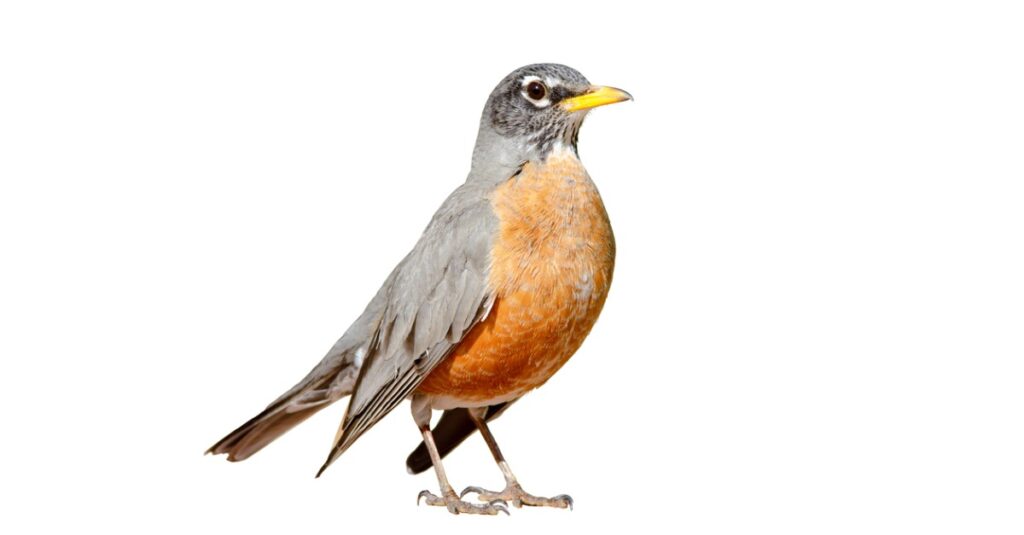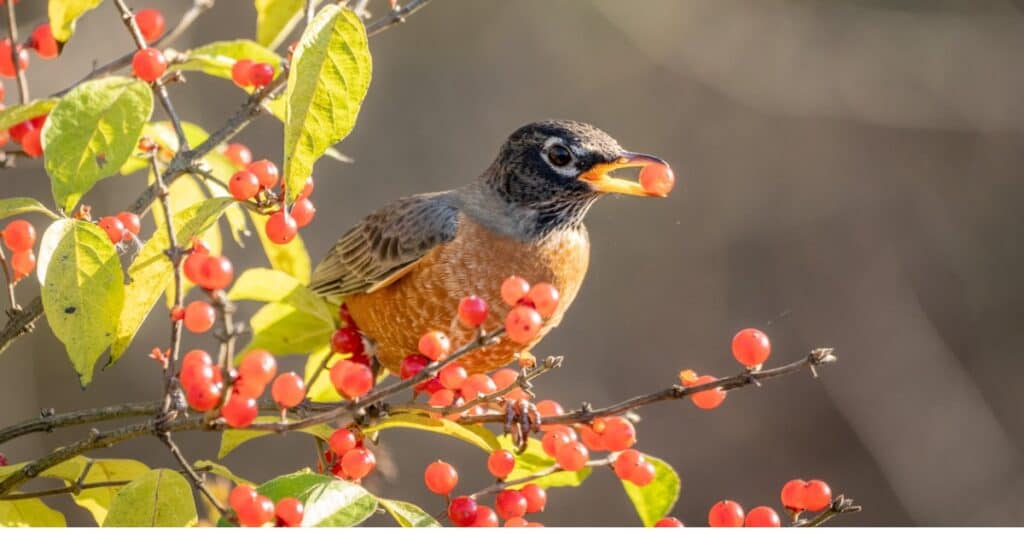Have you ever heard the phrase “robin egg blue?” If so, then you already know one of the defining features of the American robin. If not, then we’re happy to introduce you to the phrase and this delightful little bird. Meet the American robin, the bird that lays blue eggs. A member of the thrush family, the American Robin is one of the most common songbirds in North America. According to estimates from the Partners in Flight database, more than 370,000,000 American Robins live in North America, making it the most abundant bird species on the continent. As such, it serves a vital ecological function due to its position in the food chain as both predator and prey.
Due to its abundance and unique features, it’s worthwhile taking a deeper dive into this delightful backyard songbird to learn more about them. In this article, we’ll discuss the American Robin’s taxonomy, distribution, physical characteristics, social and mating behavior, eggs and offspring, diet and feeding behavior, and importance ecologically and culturally. We’ll also answer a few frequently asked questions about American robins, the bird that lays blue eggs.
Taxonomy

The American robin is a member of the thrush family.
©iStock.com/PhotosByMSA
First described in 1766, the American robin belongs to the genus Turdus, or the thrush family, whose members typically include songbirds with rounded heads and long, pointed wings. While the American robin is named after the European robin, the two do not share close familial ties. Debate continues to rage over the genetic lineage of the American robin, with some scientists claiming it is more closely related to African as opposed to North American thrushes. In total, scientists identify seven distinct subspecies of the American robin, which get their names largely due to their geographic distribution throughout North America. These subspecies include the eastern robin, the Newfoundland robin, the southern robin, the northwestern robin, the western robin, the San Lucas robin, and the Mexican robin. Of these subspecies, only the San Lucas robin stands out as distinct, due to its grayish-brown coloring on its undersides.
Distribution
American robins live throughout North America from Canada and Alaska in the north to Mexico in the south. During the winter, most robins will migrate south of their natural habitat and spend time in Florida, central Mexico, or along the Pacific Coast. In fact, the American robin’s Latin name, Turdus migratorius, translates roughly to “thrush that migrates.” Depending on where they spend their summer, some birds may end up migrating hundreds or even thousands of miles to reach the region where they overwinter. Although American robins occasionally appear in Europe, Greenland, and some islands in the Caribbean, sightings happen infrequently. Due to its widespread distribution and abundance, the IUCN lists the American robin as a species of Least Concern. That said, it is also forbidden to hunt American robins without a permit, as they receive protection under the Migratory Bird Treaty Act.
Physical Characteristics

The American robin features a brown back, white markings, and a distinctive red breast.
©iStock.com/spates
Outside of the San Lucas robin, most American robins share similar physical characteristics. On average, they measure 9.1 to 11 inches long and sport a wingspan from 12 to 16 inches long. Typically, males weigh between 2.5 to 3.3 ounces, with an average weight of 2.7 ounces. Females measure slightly smaller, with most ranging from 2.1 to 3.2 ounces. Like the European robin, the American robin features an orange-red splash of color on its belly, which can vary from maroon to pinkish-orange. Back feathers are usually brown, and the head feathers can range from gray to black. Most American robins feature white markings on their throat, around the eyes, and on their covert feathers located near the breast and undertail. Their bills primarily appear yellow, but often end in a dark tip. As in most bird species, females tend to look duller than males.
Social and Mating Behavior
American robins are diurnal, meaning they sleep at night. During the day, they mostly hunt and forage for food alone, but will gather in large flocks at night to sleep. However, during the mating season in the summer, they become more territorial and tend to act less socially. American robins prefer to make their nests in wooded areas, open grasslands, or urban environments. American robins may hatch multiple broods each mating season, which generally lasts from April to July. Females will construct a new nest for each brood, and they tend to locate their nests in dense bushes or trees. In urban areas, robins will also build their nests underneath the awnings of buildings. Nests contain several layers, including an outer layer made of grass, twigs, and feathers, and an inner layer lined with mud and covered with soft grass or vegetation.
Eggs and Offspring
Female American robins generally lay from 3 to 5 eggs at a time. The female is solely responsible for incubating the eggs, while the males work to gather food and protect the nest. American robin eggs usually appear pale blue, also known as robin egg blue. The shade is similar to a greenish-blue color, although there is a significant amount of variance between eggs. Some eggs will look paler, while others will contain brown freckles or specks. After around 14 days, the eggs will hatch, and the hatchlings will then leave the nest after another 14 days. During the time that juveniles live in their parents’ nests, adult female and male American robins will work to protect and feed their offspring. Occasionally, brown-headed cowbirds will target American robins and lay their eggs inside a robin’s nest. However, few cowbird eggs ever hatch, as American robins frequently reject cowbird eggs.
Diet

American robins primarily eat berries and fruits, but also eat a substantial amount of insects.
©iStock.com/weaver1234
The American robin primarily subsists on fruits and berries, but small invertebrates also make up a substantial portion of its diet. Favorite fruits include fermented pyracantha or firethorn berries, which can induce a drunken-like stupor when eating in large quantities. Meanwhile, common invertebrates include insects such as earthworms, grubs, caterpillars, and grasshoppers. Juvenile robins typically eat earthworms and other softer insects, although they will also eat berries. American robins hunt primarily by sight, but also rely on their sense of hearing and smell to locate prey. You can frequently see them running across the grass in search of earthworms, which they can detect merely by listening for vibrations in the ground.
Ecological and Cultural Importance
As abundant omnivores, American robins serve an important role in the ecosystems where they live. They prey on insects and worms and help to maintain populations of small invertebrates within their territory. In addition, a number of different species prey on American robins, including hawks, cats, and snakes. As such, they both control and maintain the population of several different animal species. Culturally, the American robin delights many bird enthusiasts with their varied and complex array of vocalizations. It serves as the state bird of Connecticut, Michigan, and Wisconsin, and feature frequently in song, literature, and television. The American robin is synonymous with spring, fertility, and rebirth, as they are one of the earliest brooding bird species.
Frequently Asked Questions About American Robins
Will American robins live in a birdhouse?
Most American robins will not live in an artificial birdhouse, as they do not build or live in cavity nests. However, they may choose to build their nest on an artificial nesting platform if one is available.
How many American robins make it to adulthood?
Unfortunately, only around 10-25% of American robins reach adulthood. Most young robins fall prey to predators early in life.
How long do American robins live?
In the wild, most robins won’t live to see adulthood. Those that do reach adulthood live on average around 6 years, but can live up to 14 years. In captivity, they can live up to 17 years old.
The photo featured at the top of this post is © Danita Delimont/Shutterstock.com
Thank you for reading! Have some feedback for us? Contact the AZ Animals editorial team.






